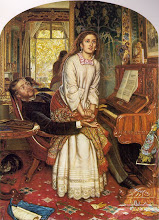
This is a re-post from earlier this year, in honor of the Feast of Saint Mary Magdalene, patroness of penitents.
The sinful woman who, in a dramatic gesture of penitence, washes Christ’s feet with her tears in Luke 7:36-50 is never identified as Mary Magdalene, the sinful woman from whom Christ drove out seven devils (Luke 8:2-3), but Pope Saint Gregory the Great, in his thirty-third homily, conflated the two women, also declaring Mary of Bethany (mentioned in Luke 10:38-42 and John 11) to be one and the same.
The Vatican reversed Gregory’s conflation in 1969, but it has always seemed to me, as it has to millions of believers from the seventh century on, that he knew what he was about: his conflation gave the Church a powerful figure of repentance and spiritual renewal, at once a reformed prostitute, a watcher at the Crucifixion, the first contemplative (in her identification with Mary of Bethany), and, finally, as the first witness to the Resurrection, apostola apostolorum -- the Apostle to the Apostles. In the Middle Ages, Mary Magdalene also came to be identified with with the woman taken in adultery (John 8:1-11), and with the Samaritan woman living, without benefit of marriage, with her sixth “husband” (John 4:1-42).
If we read the Gospels as a linear narrative, then the incident in which the penitent sinner anoints Christ's feet at the house of Simon the Pharisee precedes the similar incident described in John 12:1-11, in which Mary of Bethany anoints His feet at another dinner, six days before the Passover seder that precedes His arrest. It seems to me that these are meant to be two separate incidents, not two different retellings of the same one. We recognize Mary as the penitent sinner because she has performed once again her unique and beautiful act of penitence and reverence.
Devotion to the Magdalene was strong in the Middle Ages, when popuar belief held that, after her conversion, she had been miraculously restored to the state of virinity. A thirteenth-century calendarium refers to her as “Magdalene virginis,” and a sermon by a Syrian monk from the eleventh century calls her “Our Lady Magdalene." Saint Godric, a twelfth-century English hermit, received a vision in which the Virgin Mary and Mary Magdalene appeared to him together and taught him a song, a striking example of two saints who seem in our time to possess distinctly different, almost opposing, ethoi, mystically joined together in the practice of music.
I used to wonder about the passage in Luke in which Christ declares to Simon: "Wherefore I say unto thee, Her sins, which are many, are forgiven; for she loved much." Did He mean, I wondered, that He forgave her because she showed her love for and faith in Him so dramatically? However, I believe now that somehow she knew, in a motion of the heart, that she was already forgiven; and that therefore she gathered up her ointment and rushed off to Simon's house in an outpouring of love.











No comments:
Post a Comment